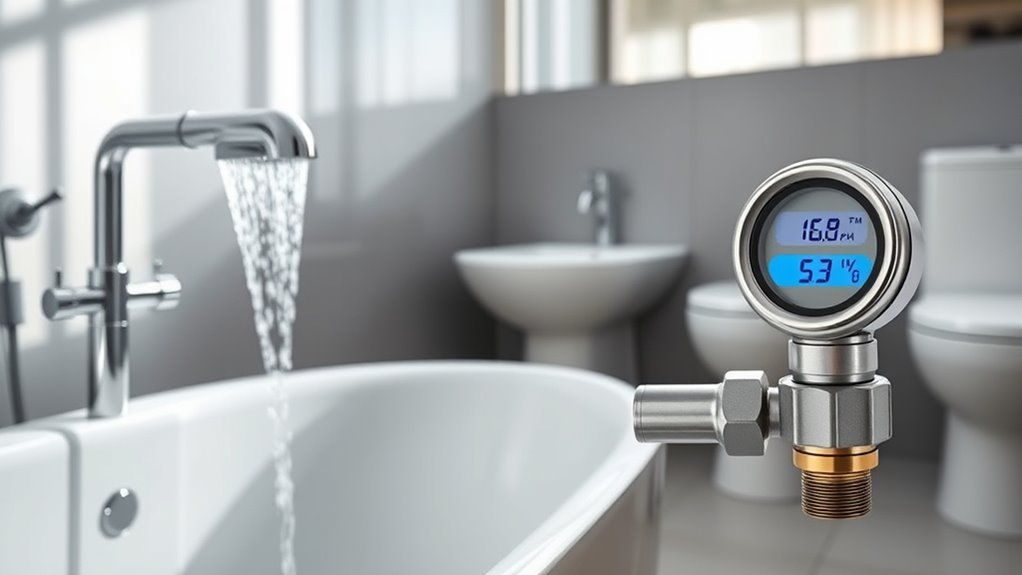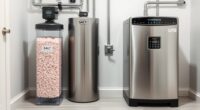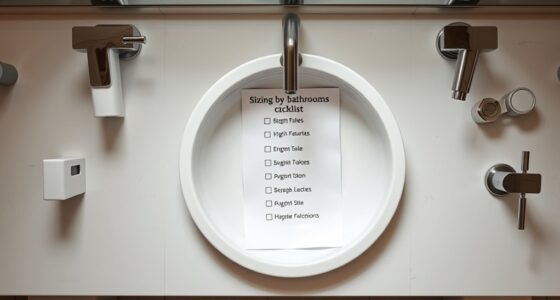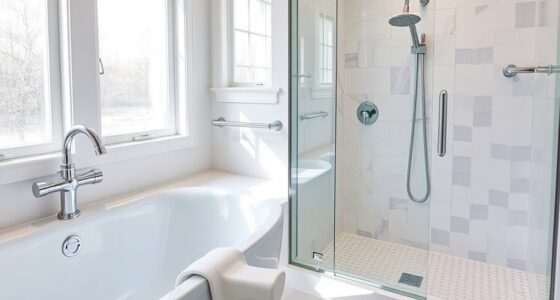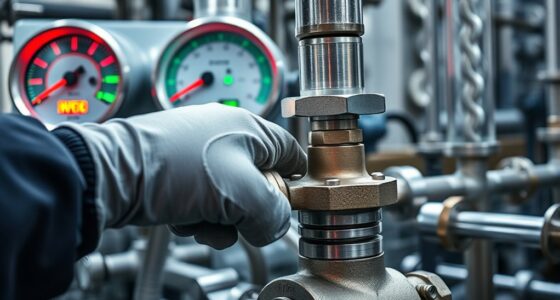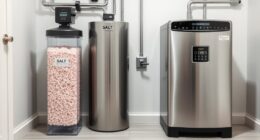To determine your household GPM needs, add the flow rates of fixtures you’ll use at the same time. For example, if two showers (2.0 GPM each) and a kitchen faucet (1.5 GPM) run together, your peak demand is about 5.5 GPM. Consider typical usage times, like mornings or evenings, to get an accurate picture. To guarantee your water heater can handle these needs without running out of hot water, keep exploring for detailed guidance.
Key Takeaways
- Identify all fixtures used simultaneously and sum their flow rates to estimate peak household GPM demand.
- Use standard flow rates: showers (2.0-2.5 GPM), faucets (~1.5 GPM), tubs (4-8 GPM).
- Consider household usage patterns, especially mornings, to determine realistic peak demand periods.
- Add the flow rates of fixtures likely used together during peak times for accurate sizing.
- Select a water heater with capacity matching or exceeding the calculated peak GPM to ensure sufficient hot water.
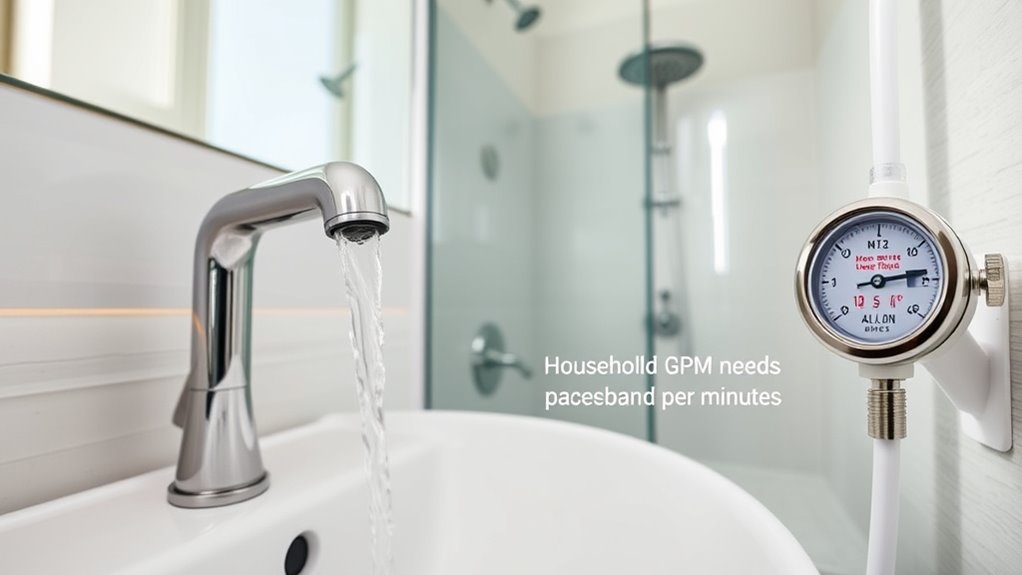
Understanding your household’s GPM (gallons per minute) needs is essential for selecting the right water system. When you’re looking at water heater sizing, knowing how much water your household uses at peak times helps ensure you won’t run out of hot water when you need it most. To do this accurately, you need to consider fixture flow rates—how much water each fixture consumes per minute—and how many fixtures are used simultaneously. This way, you can determine your total GPM demand and choose a system that can handle your household’s needs efficiently.
Start by listing all the fixtures in your home—faucets, showers, bathtubs, and appliances—that use water. Each fixture has a specified flow rate, usually listed in gallons per minute (GPM). For example, a standard showerhead typically has a flow rate of about 2.0 to 2.5 GPM, while a kitchen faucet might use around 1.5 GPM. Bathtubs fill at a rate of roughly 4 to 8 GPM, but since baths are usually filled once or twice a day, they don’t substantially impact peak GPM calculations. Conversely, multiple fixtures running at once—say, someone showering while another is washing dishes—combine their flow rates. To accurately determine your household’s GPM needs, you need to add up the flow rates of all fixtures likely to operate simultaneously.
Once you’ve identified the flow rates, consider your household’s usage patterns. For instance, in the mornings, it’s common for multiple people to shower or run appliances simultaneously. Add those fixture flow rates together to find your peak demand. If, for example, two showers (each 2.0 GPM) and a kitchen faucet (1.5 GPM) are used at the same time, your total GPM demand would be around 5.5 GPM. This figure helps you select a water heater that can supply enough hot water without delay or shortfall. Remember, choosing a water heater that’s too small may result in running out of hot water during peak times, while going too large could be unnecessary and more costly. Additionally, understanding drivetrain components and their wear can help you maintain your household fixtures and prevent leaks or inefficiencies that could affect overall water demand.
Frequently Asked Questions
How Do Plumbing Fixtures Affect Household GPM Requirements?
Plumbing fixtures directly impact your household GPM needs because water pressure and pipe diameter determine flow rates. High-demand fixtures like multiple showers or tubs require stronger water pressure to deliver adequate flow, while larger pipe diameters help maintain consistent GPM. If your fixtures demand more water, you’ll need a system with higher water pressure and wider pipes to ensure smooth operation without dips in flow.
What Are the Signs of Insufficient Household Water Flow?
You might notice sluggish water flow or inconsistent pressure, indicating insufficient household water flow. Low water pressure often results from narrow pipe diameters or blockages, causing water to struggle reaching fixtures. If multiple fixtures are used simultaneously, and the flow drops considerably, it’s a sign your pipe diameter may be undersized for your household’s needs. Keep an eye out for these signs to prevent inconvenience and guarantee proper water delivery.
Can GPM Needs Change With Household Size?
Yes, your household water demand can change with household size, especially if you add more fixtures or people. Larger households typically need higher GPM to meet demand, but fixture efficiency also matters. More efficient fixtures reduce water use, which might lower your GPM needs despite increased household size. Regularly reevaluate your household water demand to make certain your plumbing system matches your current household size and fixture efficiency.
How Do Bathroom Fixture Types Influence GPM Calculations?
Bathroom fixture types directly influence GPM calculations because different fixtures have varying flow rates, affecting water usage and fixture longevity. For example, low-flow faucets and showerheads conserve water and maintain consistent water temperature, reducing wear on plumbing. In contrast, older fixtures with higher GPM may cause fluctuations in water temperature and strain your system. Understanding these differences helps you select fixtures that balance efficiency, fixture longevity, and consistent water temperature.
Is It Necessary to Adjust GPM Based on Water Conservation Measures?
Yes, you should adjust GPM based on water conservation measures. Water-saving innovations and fixture efficiency improvements reduce flow rates, so updating your GPM calculations guarantees accurate water usage estimates. Incorporating these measures helps you identify potential savings and plan for sustainable water use. By factoring in fixture efficiency, you can better manage your household’s water consumption, ultimately lowering your utility bills and supporting environmental conservation efforts.
Conclusion
By understanding your fixtures and bathroom needs, you can pinpoint your household’s GPM requirements with precision. Don’t underestimate the power of this knowledge—it’s your secret weapon to avoiding massive water waste and skyrocketing bills. When you tailor your flow rates perfectly, you’ll be conserving water like a superhero saving the planet—one drop at a time. So, take charge now, and turn your home into a water-efficient fortress that even the most advanced technology would envy!
